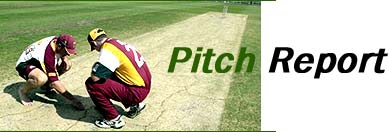Home > Cricket > Special >
M. Chinnaswami Stadium, Bangalore
May 12, 2003

Karnataka State Cricket Association
Date of inspection: 22 September 2002
Present: K.M. Ram Prasad (President)
Brijesh Patel (Hon. Secretary, Chairman Selection Committee)
Kasturi Rangan (Grounds Committee Chairman)
Narayan Raju (Grounds Committee)
K Sriram (Grounds Committee)
Sudhakar Rao (Assistant Secretary Co-ordinator)
Nagesh (Ground In charge)
Rama (Chief grounds man)
Bill Walmsley (NZ Sports Turf Institute)
Present condition of ground
The cricket square was reconstructed to BCCI specifications last year, 12 pitches wide. The pitch used for the England test match last year had good pace and bounce.
The pace and bounce has improved after reconstruction. There is some concern that the bounce is still a little lower than desirable and the pace becomes slower with time.
The outfield is in superb condition. It has responded well to corning fertilizing and topdressing. The outfield is well irrigated with pop-up sprinklers, aluminum pipes and big gun sprinklers.
Prospects for sporting pitches
I look forward with interest to hearing how well the pitch plays over the coming year.
I am surprised to see a heavy silt soil has been used, and not a black clay soil. It would be worthwhile having a lab analysis carried out on all soils used for cricket in India so the clay content of the soils can be compared.
It is important to be precise about each stage of pitch preparation. I recommend using a corer or screwdriver to assess soil moisture content in the pitch daily.
Do not start pitch preparation until moisture has penetrated adequately to 100mm depth. Hand water daily to maintain constant water content in the block. As the soil becomes more compact, moisture penetration will become more difficult.
The heavy silt soil is easily compacted, so the use of a light roller of 1 tonne weight (or even less) should still produce acceptable results, once initially consolidated.
The heavy silt soil could benefit from being decompacted at the end of the playing season. Loosen the soil by hand forking, coring or both.
Limitations on producing a quality outfield
Outfield turf is excellent following coring, fertilizing and irrigation. Take care not to apply too much fertilizer or thatch will rapidly build up. Coring and topdressing with soil helps to limit thatch build up. So does raking or scarifying. I suggest that it may be necessary to use a sacrifier on the outfield in addition to the current treatments if there are signs of thatch build up.
The topdressing mixture used on the outfield is 40% sand plus coir and red soil.
If adding sand to soil is to be of any use, it needs to be added in a high proportion such as this. Adding sand to a red soil which has a high sand content already, is a better idea than mixing it with a silty soil of low sand content.
I am not convinced that adding sand to soil is necessary at all. I would prefer to see red soil and coir mixed together and used as topdressing.
It is good to see an NPK fertilizer 14:10:27 used for fertilizing the outfield.
I recommend applying no more than 125 kg/ha (110 1b/acre) per application. Repeat applications as often as necessary to maintain density
Equipment limitations
The KSCA is in the process of purchasing new roller. Note that lawn mower `dethatching' reels (or more correctly verti-cutting reels) should be used frequently for verti-cutting. Scarifying is carried out using a dedicated scarifying machine, such as a `Garden' or `SISIS' brand. Consideration should be given to purchasing a scarifier if thatch build up warrants it.
There is a need for more outfield mowers
Both Toro and Atco mowers are suitable for the purpose. When verti-cutting (`dethatching') reels are available they should be used lightly and frequently particularly on the cricketsquare and other area where fine foliage presentation is required.
< Back | Back to start >
More Specials